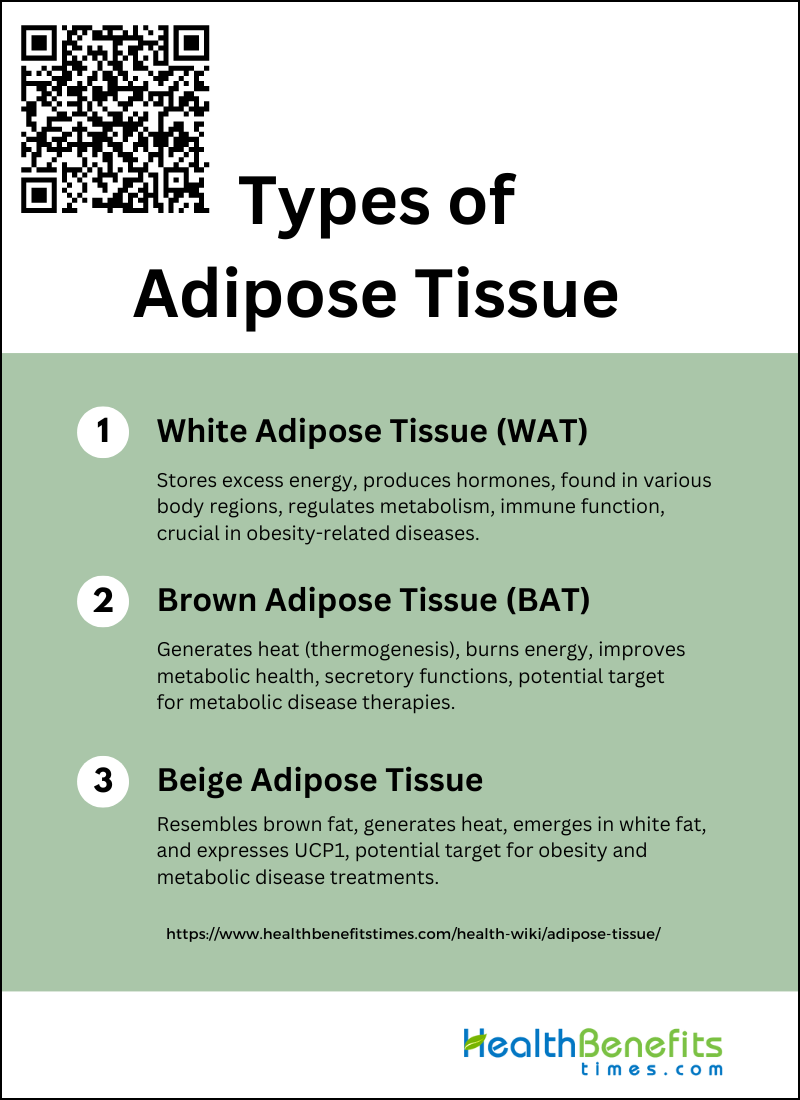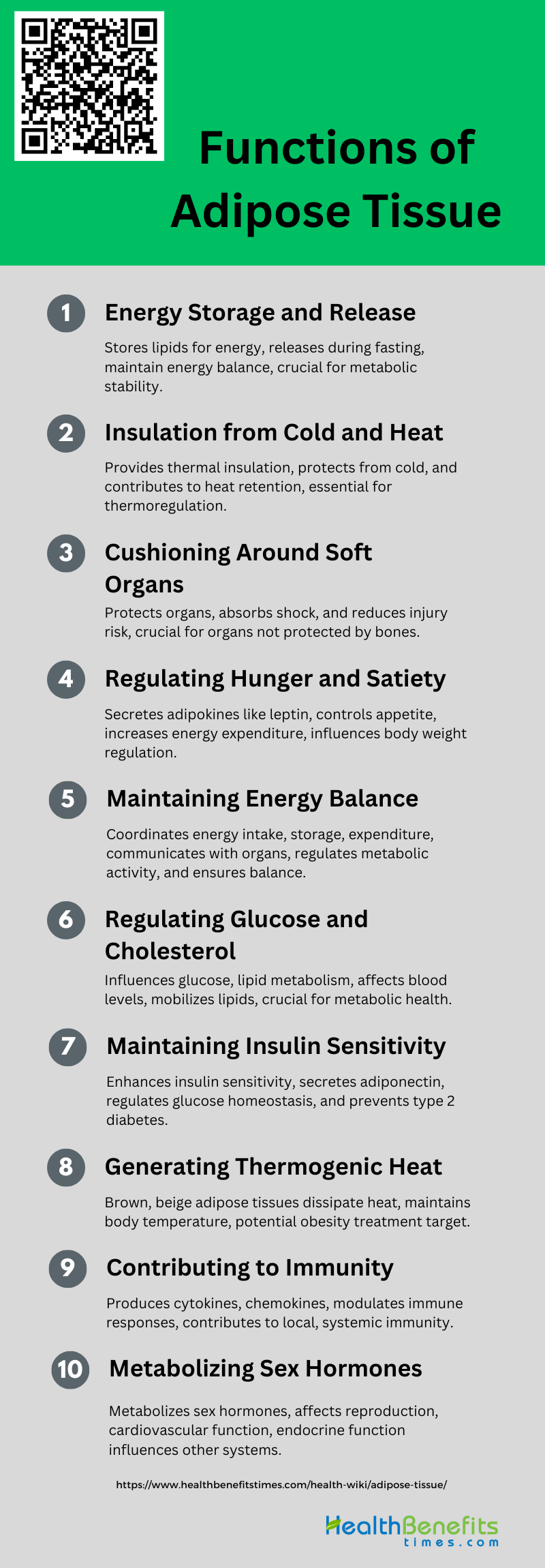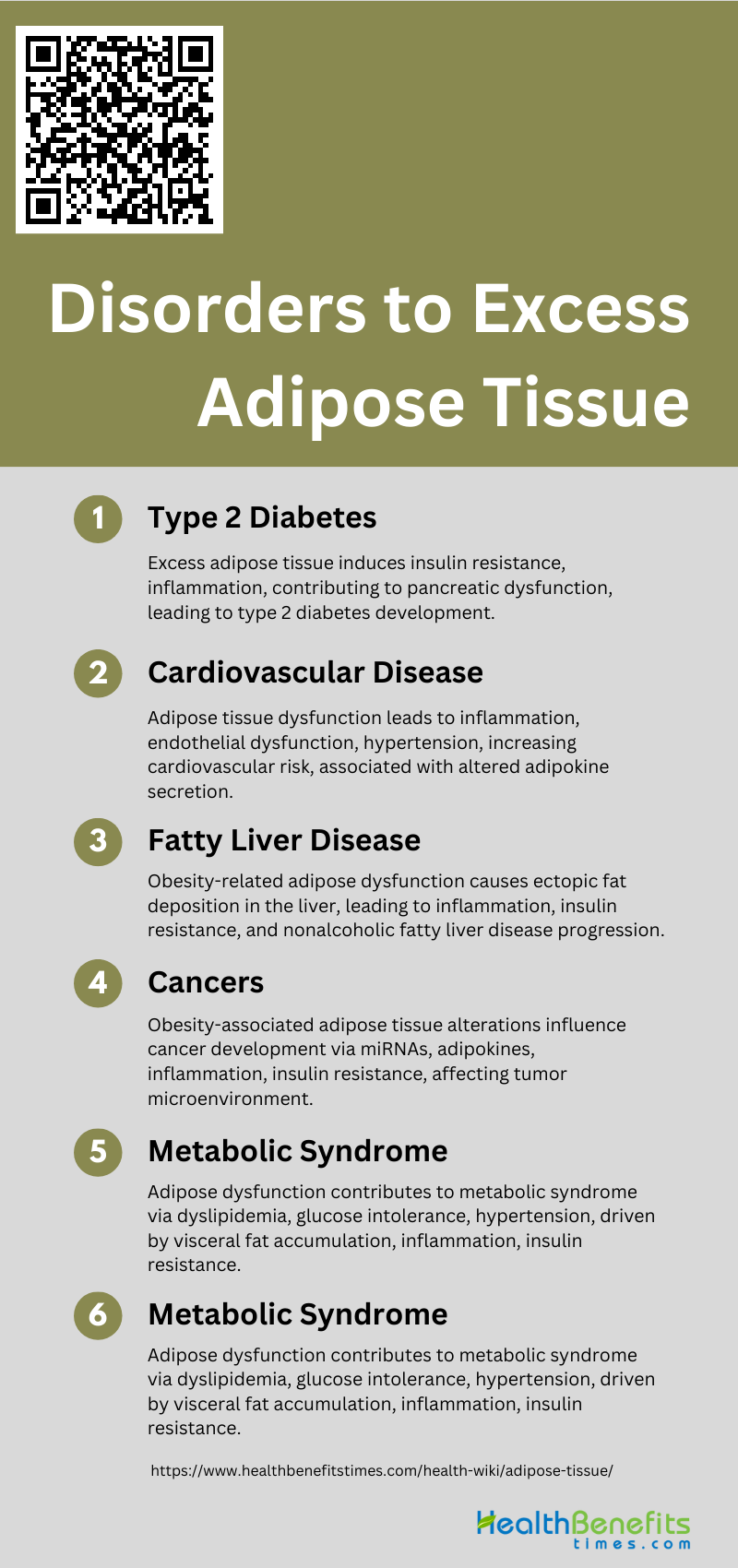 Adipose tissue, commonly referred to as body fat, is an essential organ that plays a crucial role in maintaining energy equilibrium and overall metabolic well-being. It serves as the primary storage for excess calories in the form of lipids, which can be released as needed. Apart from its energy storage function, adipose tissue also acts as an endocrine organ by producing adipokines, which are bioactive substances. These adipokines are involved in regulating vital physiological processes like appetite, metabolism, immune response, and cardiovascular function.
Adipose tissue, commonly referred to as body fat, is an essential organ that plays a crucial role in maintaining energy equilibrium and overall metabolic well-being. It serves as the primary storage for excess calories in the form of lipids, which can be released as needed. Apart from its energy storage function, adipose tissue also acts as an endocrine organ by producing adipokines, which are bioactive substances. These adipokines are involved in regulating vital physiological processes like appetite, metabolism, immune response, and cardiovascular function.
Types of Adipose Tissue
1. White adipose tissue (WAT)
White adipose tissue (WAT) is a complex organ that helps maintain the body’s energy balance. It stores excess energy as triglycerides when there is too much food and releases fatty acids when there is a shortage of energy. WAT is not just a storage depot, but also produces hormones and metabolites that regulate energy balance, glucose levels, and inflammation. WAT is found in various depots throughout the body, including visceral and subcutaneous regions, each with distinct structural and biochemical characteristics. WAT also plays a role in the immune system by storing memory T cells. It can change its size and number of fat cells based on nutrient availability and hormonal signals. When WAT doesn’t function properly, especially in obesity, it can lead to metabolic diseases. Understanding the various roles of WAT is important for developing treatments for metabolic disorders and obesity-related complications.
2. Brown adipose tissue (BAT)
Brown adipose tissue (BAT) is a unique type of fat tissue that can convert chemical energy into heat, which is called thermogenesis. Unlike white adipose tissue that stores energy, BAT is responsible for energy expenditure and helps maintain body temperature, especially in cold environments. Recent studies have revealed that BAT is not only found and functional in newborns and infants but also in adults. It plays a crucial role in regulating energy balance and metabolic health. BAT activity has been associated with improved insulin sensitivity, glucose regulation, and a reduced risk of metabolic diseases like obesity and type 2 diabetes. Moreover, BAT has been identified as a secretory organ, releasing various molecules that can affect the function of other tissues. This discovery opens up new possibilities for developing therapies for metabolic diseases. The presence of BAT in adults has led to a renewed interest in studying adipose biology, which has important implications for understanding and treating obesity and its related metabolic complications.
3. Beige adipose tissue
Beige fat, also known as beige adipose tissue, is a type of fat cell that has similarities to brown fat. Unlike white fat, which stores energy, beige fat can release energy as heat through thermogenesis. Beige fat cells can appear within white fat tissue under certain conditions, such as exposure to cold or certain hormones, a process known as “browning”. These cells have lipid droplets and mitochondria like brown fat cells, and they express a protein called UCP1, which is important for their ability to generate heat. The presence of beige fat in adults suggests it could be a potential target for treating obesity and metabolic diseases like type 2 diabetes. Beige fat can develop through the creation of new fat cells or the transformation of white fat cells. Because beige fat can regulate metabolism and energy expenditure, it is an interesting area for developing treatments for metabolic diseases.
Functions of Adipose Tissue
Below is a list of the key functions that adipose tissue performs within the human body, highlighting its importance beyond mere energy storage.
1. Energy storage and release
This energy can be mobilized and distributed throughout the body when needed, particularly during periods of fasting or increased energy demand. The dynamic nature of adipose tissue allows for the balance of lipid storage and mobilization, which is crucial for maintaining energy homeostasis.
2. Insulation from cold and heat
Especially brown adipose tissue plays a vital role in thermoregulation. It provides insulation from environmental temperature changes, protecting the body from cold and contributing to heat retention. Brown adipose tissue is particularly important for non-shivering thermogenesis, a process that generates heat by metabolizing lipids in response to cold exposure.
3. Cushioning around soft organs
The adipose tissue acts as a protective cushion around vital organs, absorbing shock and reducing the risk of injury. This mechanical protection is particularly important for organs that are not protected by bones, such as the eyes and kidneys, and for those located in areas subject to impact or pressure.
4. Regulating hunger and satiety
Such as leptin, which play a significant role in regulating hunger and satiety are secretes various adipokines of adipose tissue, Leptin signals the brain to reduce appetite and increase energy expenditure when energy stores are sufficient, thereby contributing to the control of body weight and food intake.
5. Maintaining energy balance
The adipose tissue is central to the regulation of whole-body energy balance. It communicates with other organs through the secretion of adipokines, which influence appetitive signals and metabolic activity, thereby coordinating energy intake, storage, and expenditure.
6. Regulating glucose and cholesterol
It influences glucose and lipid metabolism, affecting the levels of glucose and cholesterol in the bloodstream. It plays a role in lipid mobilization and distribution, and its dysfunction can lead to metabolic disorders such as insulin resistance and dyslipidemia.
7. Maintaining insulin sensitivity
The proper functioning of adipose tissue is essential for maintaining insulin sensitivity. Adipokines secreted by adipose tissue, such as adiponectin, have been shown to enhance insulin sensitivity in peripheral tissues, thus playing a role in glucose homeostasis and the prevention of type 2 diabetes.
8. Generating thermogenic heat
Brown and beige adipose tissues are specialized in dissipating energy as heat, a process known as thermogenesis. This is particularly important for maintaining body temperature (euthermia) and can be a potential target for combating obesity.
9. Contributing to immunity
It is now recognized as an immunological organ, with adipocytes and preadipocytes producing cytokines, chemokines, and hormone-like factors that have immunomodulatory functions. These adipose-derived proteins contribute to both local and systemic immune responses.
10. Metabolizing sex hormones
The metabolism of sex hormones, which can have significant effects on reproduction, cardiovascular function, and overall health. The endocrine function of adipose tissue directly influences other organ systems, including the modulation of sex hormone levels.
Disorders and treatment related to Excess Adipose Tissue
It can contribute to psychological distress and a decreased quality of life. Addressing these disorders requires a multifaceted approach that encompasses lifestyle modifications, medical interventions, and in some cases, surgical procedures. The following list outlines some of the most prevalent disorders and their corresponding treatments related to excess adipose tissue.
1. Type 2 Diabetes
Excess adipose tissue, particularly visceral fat, contributes to the development of type 2 diabetes mellitus (T2DM) through mechanisms such as adipocyte hypertrophy, endoplasmic reticulum stress, and inflammation, which lead to insulin resistance and pancreatic beta-cell dysfunction. The overflow of free fatty acids and the altered secretion of adipokines like tumor necrosis factor-alpha and interleukin-6 exacerbate metabolic disturbances, culminating in T2DM.
2. Cardiovascular Disease
Cardiovascular diseases (CVD) are closely linked to obesity and excess adipose tissue. Adipose tissue dysfunction, characterized by an altered secretion of adipokines and cytokines, contributes to a proinflammatory state and endothelial dysfunction. This state is associated with atherogenic changes, hypertension, and increased cardiovascular risk. Adipokines such as leptin and plasminogen activator inhibitor-1 play significant roles in the pathophysiology of obesity-related CVD.
3. Fatty Liver Disease
Nonalcoholic fatty liver disease (NAFLD) is associated with obesity and characterized by ectopic fat deposition in the liver. This condition is a result of lipotoxicity, where excess lipids spill over from adipose tissue to the liver, causing inflammation, insulin resistance, and potential progression to steatohepatitis and cirrhosis. Adipose tissue dysfunction plays a central role in the pathogenesis of NAFLD.
4. Cancers
Obesity and excess adipose tissue are risk factors for several types of cancer. Adipose tissue-derived miRNAs and adipokines can act as oncogenic or tumor suppressor molecules, influencing the tumor microenvironment. The chronic low-grade inflammation and insulin resistance associated with adipose tissue dysfunction may also contribute to cancer development and progression.
5. Metabolic Syndrome
Metabolic syndrome is a cluster of conditions including central obesity, dyslipidemia, glucose intolerance, and hypertension, which are all related to excess adipose tissue dysfunction. The syndrome is a result of the complex interplay between adipokine secretion, low-grade inflammation, and insulin resistance, which are exacerbated by the accumulation of visceral fat.
6. Dysfunctional Hunger
Excess adipose tissue affects hunger regulation by altering the secretion of hormones like leptin and adiponectin, which are involved in appetite control and energy homeostasis. Dysfunctional adipose tissue can lead to leptin resistance, where the body fails to respond to satiety signals, thus promoting overeating and further weight gain.




